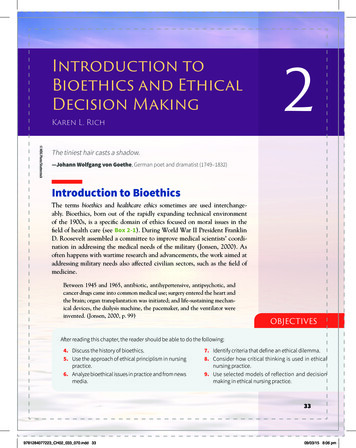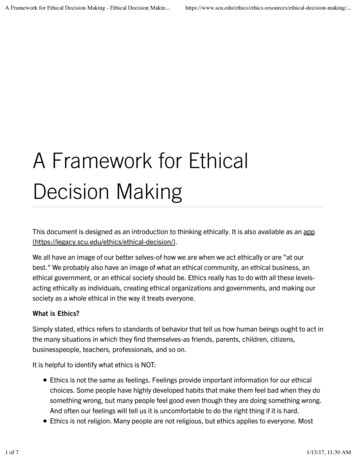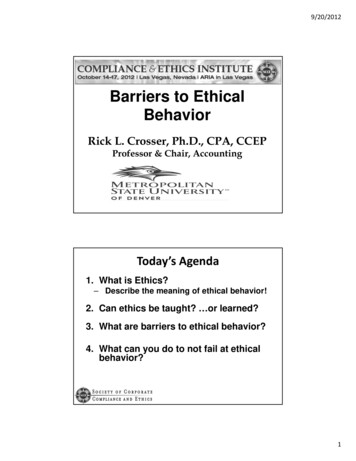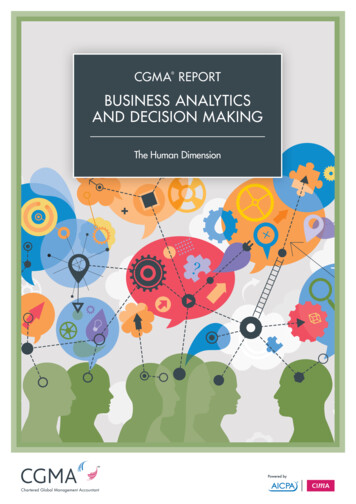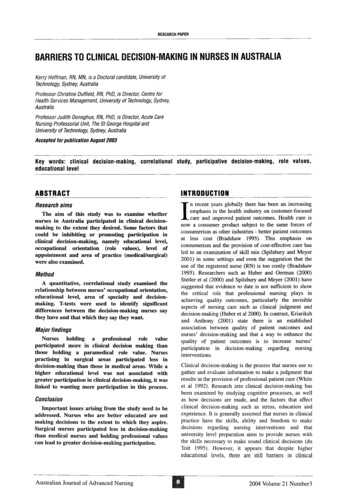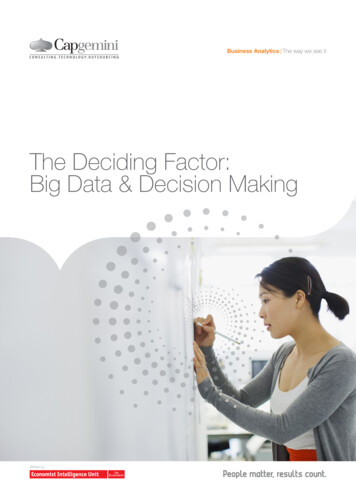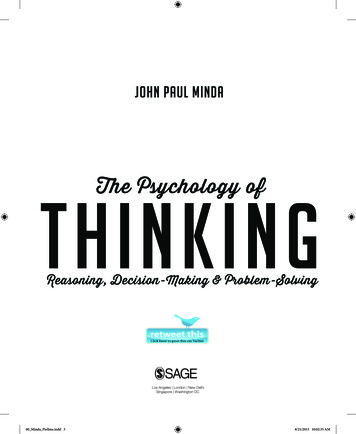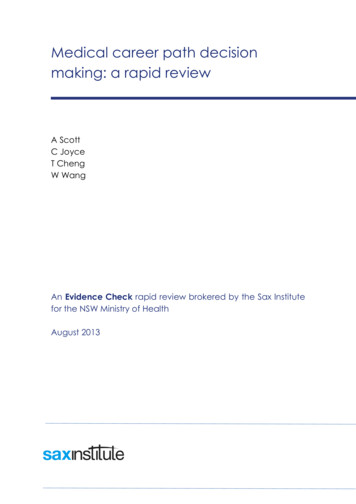
Transcription
7Ethical Decision Makingand BehaviorAs we practice resolving dilemmas we find ethics to be less a goalthan a pathway, less a destination than a trip, less an inoculationthan a process.—Ethicist Rushworth KidderWHAT’S AHEADThis chapter surveys the components of ethical behavior—moral sensitivity,moral judgment, moral motivation, and moral character—and introducessystematic approaches to ethical problem solving. We’ll take a look at fourdecision-making formats: Kidder’s ethical checkpoints, the SAD formula, Nash’s12 questions, and the case study method. After presenting each approach, I’lldiscuss its relative advantages and disadvantages.Understanding how we make and follow through on ethical decisions isthe first step to making better choices; taking a systematic approach isthe second. We’ll explore both of these steps in this chapter. After examiningthe ethical decision-making process, we’ll see how guidelines or formats canguide our ethical deliberations.235
236——PART III. Ethical Standards and StrategiesComponents of Moral ActionThere are a number of models of ethical decision making and action. Forexample, business ethics educators Charles Powers and David Vogel identify sixfactors or elements that underlie moral reasoning and behavior and that areparticularly relevant in organizational settings.1 The first is moral imagination,the recognition that even routine choices and relationships have an ethicaldimension. The second is moral identification and ordering, which, as the namesuggests, refers to the ability to identify important issues, determine priorities,and sort out competing values. The third factor is moral evaluation, or usinganalytical skills to evaluate options. The fourth element is tolerating moraldisagreement and ambiguity, which arises when managers disagree about valuesand courses of action. The fifth is the ability to integrate managerial competencewith moral competence. This integration involves anticipating possible ethicaldilemmas, leading others in ethical decision making, and making sure anydecision becomes part of an organization’s systems and procedures. The sixthand final element is a sense of moral obligation, which serves as a motivatingforce to engage in moral judgment and to implement decisions.James Rest of the University of Minnesota developed what may be themost widely used model of moral behavior. Rest built his four-componentmodel by working backward. He started with the end product—moralaction—and then determined the steps that produce such behavior. He concluded that ethical action is the result of four psychological subprocesses:(1) moral sensitivity (recognition), (2) moral judgment, (3) moral focus(motivation), and (4) moral character.2Component 1: Moral Sensitivity (Recognition)Moral sensitivity (recognizing the presence of an ethical issue) is the first stepin ethical decision making because we can’t solve a moral problem unless wefirst know that one exists. A great many moral failures stem from ethicalinsensitivity. The safety committee at Ford Motor decided not to fix thedefective gas tank on the Pinto automobile (see Chapter 2) because memberssaw no problem with saving money rather than human lives. Wal-Mart wasslow to respond to concerns raised by employees, labor groups, environmentalists, and others about wage violations, sexual discrimination, poor environmental practices, and other issues.3 Many students, focused on finishingtheir degrees, see no problem with cheating. (You can test your ethical sensitivity by completing the “Self-Assessment: Moral Sensitivity Scenarios.”)According to Rest, problem recognition requires that we consider how ourbehavior affects others, identify possible courses of action, and determine the
CHAPTER 7. Ethical Decision Making and Behavior——237consequences of each potential strategy. Empathy and perspective skills areessential to this component of moral action. If we understand how othersmight feel or react, we are more sensitive to potential negative effects of ourchoices and can better predict the likely outcomes of each option.A number of factors prevent us from recognizing ethical issues. We maynot factor ethical considerations into our typical ways of thinking or mentalmodels.4 We may be reluctant to use moral terminology (values, justice,right, wrong) to describe our decisions because we want to avoid controversy or believe that keeping silent will make us appear strong and capable.5We may even deceive ourselves into thinking that we are acting morallywhen we are clearly not, a process called ethical fading. The moral aspectsof a decision fade into the background if we use euphemisms to disguiseunethical behavior, numb our consciences through repeated misbehavior,blame others, and claim that only we know the “truth.”6Fortunately, we can take steps to enhance our ethical sensitivity (and thesensitivity of our fellow leaders and followers) by doing the following: Active listening and role playingImagining other perspectivesStepping back from a situation to determine whether it has moral implicationsUsing moral terminology to discuss problems and issuesAvoiding euphemismsRefusing to excuse misbehaviorAccepting personal responsibilityPracticing humility and openness to other points of viewIn addition to these steps, we can also increase ethical sensitivity bymaking an issue more salient. The greater the moral intensity of an issue, themore likely it is that decision makers will take note of it and respondethically.7 We can build moral intensity by doing the following: Illustrating that the situation can cause significant harm or benefit to manypeople (magnitude of consequences) Establishing that there is social consensus or agreement that a behavior ismoral or immoral (e.g., legal or illegal, approved or forbidden by a professional association) Demonstrating probability of effect, that the act will happen and will causeharm or benefit Showing that the consequences will happen soon (temporal immediacy) Emphasizing social, psychological, physical, or psychological closeness (proximity) with those affected by our actions Proving that one person or a group will greatly suffer due to a decision (concentration of effect)
238——PART III. Ethical Standards and StrategiesFinally, paying attention to our emotions can be an important clue thatwe are faced with an ethical dilemma. Moral emotions are part of ourmakeup as humans.8 These feelings are triggered even when we do not havea personal stake in an event. For example, we may feel angry when readingabout mistreatment of migrant workers or sympathy when we see a pictureof a refugee living in a squalid camp. Moral emotions also encourage us totake action that benefits other people and society as a whole. We might writea letter protesting the poor working conditions of migrant laborers, forinstance, or send money to a humanitarian organization working withdisplaced persons.Anger, disgust, and contempt are other-condemning emotions. They areelicited by unfairness, betrayal, immorality, cruelty, poor performance, andstatus differences. Anger can motivate us to redress injustices like racism,oppression, and poverty. Disgust encourages us to set up rewards and punishments to deter inappropriate behaviors. Contempt generally causes us tostep back from others. Shame, embarrassment, and guilt are self-consciousemotions that encourage us to obey the rules and uphold the social order.These feelings are triggered when we violate norms and social conventions,present the wrong image to others, and fail to live up to moral guidelines.Shame and embarrassment can keep us from engaging in further damagingbehavior and may drive us to withdraw from social contact. Guilt motivatesus to help others and to treat them well.Sympathy and compassion are other-suffering emotions. They are elicitedwhen we perceive suffering or sorrow in our fellow human beings. Such feelings encourage us to comfort, help, and alleviate the pain of others.Gratitude, awe, and elevation are other-praising (positive) emotions thatopen us up to new opportunities and relationships. They are prompted whensomeone has done something on our behalf, when we run across moralbeauty (acts of charity, loyalty, and self-sacrifice, for example), and when weread or hear about moral exemplars (see Chapter 3). Gratitude motivates usto repay others; awe and elevation encourage us to become better personsand to take steps to help others.In sum, if we experience anger, disgust, guilt, sympathy, or other moralemotions, the chances are good that there is an ethical dimension to thesituation that confronts us. We will need to look further to determine if thisis indeed the case.
CHAPTER 7. Ethical Decision Making and Behavior——239SELF-ASSESSMENTMORAL SENSITIVITY SCENARIOSInstructionsRead each vignette and consider the following statement:There are very important ethical aspects to this situation. (1 strongly disagree,7 strongly agree)Then briefly explain your rating for each vignette in the space below it. For moreinformation on the ethical issues raised by the scenarios, see Item 1 under “ForFurther Exploration, Challenge, and Self-Assessment.”Vignette 1One of your most important customers, a medical clinic, called yesterday. The clinichad ordered a product 10 days ago (products are normally delivered within 7–10days), but it had not arrived. Quickly, you traced the order to the shipping office. Youasked the shipping clerk about the order, and she said, “I shipped it 2 days ago!” Asyou left the shipping office, you glanced at her desk and saw her shipping receipts.You could clearly see that the order was shipped this morning. You called the clientback with the news that the product was on its way. As you talked with the client, youlearned that the delay of the product had allowed the condition of some patients toworsen quite dramatically.Vignette 2Last Monday, you were sitting at your desk examining a request that a customer hadjust faxed to you. The customer was proposing a project that would make a tremendous amount of money for your company but had an extremely demanding timeschedule. Just as you were about to call the customer and accept the project, one ofyour employees, Phil, knocked on the door. He entered your office, politely placed aletter of resignation on your desk, and told you he was sorry, but in two weeks, he
240——PART III. Ethical Standards and Strategieswould be moving to another state to be closer to his ailing parents. After he left, youthought about the proposed project and determined that even though Phil would begone, you could still meet all of the customer’s deadlines. You called the customerand accepted the project.Vignette 3Earlier today, a salesman who works in Iowa called you and told you about an experience he had last week. One of his customers placed a small order of about 1,500worth of product from corporate headquarters. The home office immediately shippedthe package through a freight company, and it arrived the next day at the freightcompany’s warehouse in Iowa. The salesman went to the warehouse just as it wasclosing and talked to one of the managers. The manager said that everyone had gonehome for the day, but he assured him that the package would be delivered directly tohis office the next day. The salesman knew that the customer did not need the materials for at least another 3 days, but he didn’t want to wait. He placed a 20 bill onthe counter and asked the warehouse manager one last time if there was anythinghe could do. The manager found the paperwork, got the product from the back of thewarehouse, and brought it out to the salesman.SOURCE: Reynolds, S. J. (2006). Moral awareness and ethical predispositions: Investigating the role ofindividual differences in the recognition of moral issues. Journal of Applied Psychology, 91, 233–243.Published by the American Psychological Association.
CHAPTER 7. Ethical Decision Making and Behavior——241Component 2: Moral JudgmentOnce an ethical problem is identified, decision makers select a course ofaction from the options generated in Component 1. In other words, theymake judgments about what is the right or wrong thing to do in this situation.Moral judgment has generated more research than the other componentsof Rest’s model. Investigators have been particularly interested in cognitivemoral development, the process by which people develop their moral reasoning abilities over time. Harvard psychologist Lawrence Kohlberg argued thatindividuals progress through a series of moral stages just as they do physicalones.9 Each stage is more advanced than the one before. Not only do peopleengage in more complex reasoning as they progress up the stages, but theyalso become less self-centered and develop broader definitions of morality.Kohlberg identified three levels of moral development, each divided intotwo stages. Level I, preconventional thinking, is the most primitive andfocuses on consequences. This form of moral reasoning is common amongchildren who choose to obey to avoid punishment (Stage 1) or follow therules in order to meet their interests (Stage 2). Stage 2 thinkers are interestedin getting a fair deal: You help me, and I’ll help you.Conventional thinkers (Level II) look to others for guidance when deciding how to act. Stage 3 people want to live up to the expectations of thosethey respect, such as parents, siblings, and friends, and value concern forothers and respect. Stage 4 individuals take a somewhat broader perspective,looking to society as a whole for direction. They believe in following rulesat work, for example, and the law. Kohlberg found that most adults areLevel II thinkers.Level III, postconceptual or principled reasoning, is the most advancedtype of ethical thinking. Stage 5 people are guided by utilitarian principles.They are concerned for the needs of the entire group and want to make surethat rules and laws serve the greatest good for the greatest number. Stage 6people operate according to internalized, universal principles such as justice,equality, and human dignity. These principles consistently guide their behavior and take precedence over the laws of any particular society. According toKohlberg, fewer than 20% of American adults ever reach Stage 5, andalmost no one reaches Stage 6.Critics take issue with both the philosophical foundation of Kohlberg’smodel and its reliance on concrete stages of moral development.10 They contend that Kohlberg based his postconventional stage on Rawls’s justice-asfairness theory and made deontological ethics superior to other ethicalapproaches. They note that the model applies more to societal issues than toindividual ethical decisions. A great many psychologists challenge the notion
242——PART III. Ethical Standards and Strategiesthat people go through a rigid or “hard” series of moral stages, leaving onestage completely behind before moving to the next. They argue instead thata person can engage in many ways of thinking about a problem, regardlessof age.Rest (who studied under Kohlberg), Darcia Narvaez, and their colleaguesresponded to the critics by replacing the hard stages with a staircase of developmental schemas.11 Schemas are networks of knowledge organized aroundlife events. We use schemas when encountering new situations or information. You are able to master information in new classes, for instance, byusing strategies you developed in previous courses. According to this “neoKohlbergian” approach, decision makers develop more sophisticated moralschemas as they develop. The least sophisticated schema is based on personalinterest. People at this level are concerned only with what they may gain orlose in an ethical dilemma. No consideration is given to the needs of broadersociety. Those who reason at the next level, the maintaining norms schema,believe they have a moral obligation to maintain social order. They are concerned with following rules and laws and making sure that regulations applyto everyone. These thinkers believe that there is a clear hierarchy with carefully defined roles (e.g., bosses–subordinates, teachers–students, officers–enlisted personnel). The postconventional schema is the most advanced levelof moral reasoning. Thinking at this level is not limited to one ethicalapproach, as Kohlberg argued, but encompasses many different philosophical traditions. Postconventional individuals believe that moral obligationsare to be based on shared ideals, should not favor some people at theexpense of others, and are open to scrutiny (testing and examination). Suchthinkers reason like moral philosophers, looking behind societal norms todetermine whether they serve moral purposes. (Refer to “Leadership Ethicsat the Movies: Michael Clayton” for an example of a leader who shifts to ahigher level of moral reasoning.)Rest developed the Defining Issues Test (DIT) to measure moral development. Subjects taking the DIT (and its successor, the DIT-2) respond to sixethical scenarios and then choose statements that best reflect the reasoningthey used to come up with their choices. These statements, which correspondto the three levels of moral reasoning, are then scored. In the best-knowndilemma, Heinz’s wife is dying of cancer and needs a drug he cannot affordto buy. He must decide whether to steal the drug to save her life.Hundreds of studies using the DIT reveal that moral reasoning generallyincreases with age and education.12 Undergraduate and graduate studentsbenefit from their educational experiences in general and ethical courseworkin particular. When education stops, moral development stops. In addition,moral development is a universal concept, crossing cultural boundaries.
CHAPTER 7. Ethical Decision Making and Behavior——243Principled leaders can boost the moral judgment of a group by encouragingmembers to adopt more sophisticated ethical schemas.13Models of cognitive development provide important insights into theprocess of ethical decision making. First, contextual variables play an important role in shaping ethical behavior. Most people look to others as well asto rules and regulations when making ethical determinations. They are morelikely to make wise moral judgments if coworkers and supervisors encourageand model ethical behavior. As leaders, we need to build ethical environments. (We’ll take a closer look at the formation of ethical groups and organizations in Chapters 8 and 9.) Second, education fosters moral reasoning.Pursuing a bachelor’s, master’s, or doctoral degree can promote your moraldevelopment. As part of your education, focus as much attention as you canon ethics (i.e., take ethics courses, discuss ethical issues in groups and classes,reflect on the ethical challenges you experience in internships). Third, abroader perspective is better. Consider the needs and viewpoints of othersoutside your immediate group or organization; determine what is good forthe local area, the larger society, and the global community. Fourth, moralprinciples produce superior solutions. The best ethical thinkers base theirchoices on widely accepted ethical guidelines. Do the same by drawing onimportant ethical approaches such as utilitarianism, the categorical imperative, altruism, communitarianism, and justice-as-fairness theory.LEADERSHIP ETHICS AT THE MOVIESMICHAEL CLAYTONKey Cast Members: George Clooney, Tilda Swinton, Tom Wilkinson, SydneyPollackSynopsis: George Clooney stars as Michael Clayton, the “fixer” for a large NewYork City firm. Clayton takes care of any messes involving clients, like hit-andrun accidents and shoplifting charges. When the firm’s top litigator (played byWilkinson) begins to work for the other side in a 3 billion lawsuit, Claytonmust get him back on his medications and under control. Karen Crowder(Swinton) is chief counsel for the conglomerate being sued for manufacturinga toxic chemical. She decides to permanently silence both the rogue lawyer andClayton. The fixer, whose life and reputation have been tarnished by a series ofpoor ethical and business choices, must now decide how to respond to illegalwiretapping and murder. Swinton won a Best Supporting Actress Oscar for her(Continued)
244——PART III. Ethical Standards and Strategies(Continued)performance as the ambitious attorney who decides that corporate survivaltakes precedence over human life.Rating: R for language, including sexual dialogueThemes: moral reasoning, the dark side of leadership, corruption, greed, character,deceptionDiscussion Starters1. What factors motivated Clayton to become a “fixer” and theconglomerate’s chief counsel to protect her company at any cost?2. Was it unethical for the law firm’s top litigator to begin to work for theplaintiffs? Why or why not?3. What accounts for Clayton’s shift to a higher level of moral reasoning?Component 3: Moral Focus (Motivation)After concluding what course of action is best, decision makers must befocused (motivated to follow through) on their choices. Moral values oftenconflict with other significant values. For instance, an accounting supervisorwho wants to blow the whistle on illegal accounting practices at her firmmust balance her desire to do the right thing against her desire to keep herjob, provide income for her family, and maintain relationships with her fellow workers. She will report the accounting abuses to outside authoritiesonly if moral considerations take precedence over these competing priorities.Psychologists report that self-interest and hypocrisy undermine moralmotivation.14 Sometimes individuals genuinely want to do the right thing,but their integrity is “overpowered” when they discover that they will haveto pay a personal cost for acting in an ethical manner. Others never intendto follow an ethical course of action but engage in moral hypocrisy instead.These decision makers “want to appear moral while, if possible, avoidingthe cost of actually being moral.”15 In experimental settings, they say thatassignments should be distributed fairly but then assign themselves the mostdesirable tasks while giving less desirable chores to others. Both self-interestand hypocrisy encourage leaders to set their moral principles aside. Forexample, corporate executives may declare that lower-level employeesdeserve higher wages. However, whether they really want to help workers or
CHAPTER 7. Ethical Decision Making and Behavior——245just want to appear as if they do, these executives are not likely to payemployees more if it means that they will earn less as a result.Rewards play an important role in ethical follow-through. People aremore likely to give ethical values top priority when rewarded through raises,promotions, public recognition, and other means for doing so. Conversely,moral motivation drops when the reward system reinforces unethical behavior.16 Unfortunately, misplaced rewards are all too common, as in the case ofelectronics retailers who reward employees for selling expensive extendedwarranties on new products. Such warranties are generally a bad deal forconsumers.Emotions also play a part in moral motivation.17 As noted earlier, sympathy, disgust, guilt, and other moral emotions prompt us to take action. Wecan use their motivational force to help us punish wrongdoers, addressinjustice, provide assistance, and so on. Other researchers report that positive emotions such as joy and happiness make people more optimistic andmore likely to live out their moral choices and to help others. Depression, onthe other hand, lowers motivation, and jealousy, rage, and envy contributeto lying, revenge, stealing, and other antisocial behaviors.To increase your moral motivation and the moral motivation of followers, seek out and create ethically rewarding environments. Make sure thereward system of an organization supports ethical behavior before joiningit as an employee or a volunteer. Try to reduce the costs of behaving morally by instituting policies and procedures that make it easier to reportunethical behavior, combat discrimination, and so on. Work to alignrewards with desired behavior in your current organization. Be concernedabout how goals are reached. If all else fails, reward yourself. Take pridein following through on your choices and on living up to your self-imageas a person of integrity. Tap into moral emotions while making a consciouseffort to control negative feelings and to put yourself in a positive frame ofmind.Component 4: Moral CharacterExecuting the plan of action takes character. Moral agents have to overcomeopposition, resist distractions, cope with fatigue, and develop tactics andstrategies for reaching their goals. This helps explain why there is only amoderate correlation between moral judgment and moral behavior. Manytimes deciding does not lead to doing.The positive character traits described in Chapter 3 contribute to ethicalfollow-through. Courage helps leaders implement their plans despite the risksand costs of doing so while prudence helps them choose the best course of
246——PART III. Ethical Standards and Strategiesaction. Integrity encourages leaders to be true to themselves and their choices.Humility forces leaders to address limitations that might prevent them fromtaking action. Reverence promotes self-sacrifice. Optimism equips leaders topersist in the face of obstacles and difficulties. Compassion and justice focus theattention of leaders on the needs of others rather than on personal priorities.In addition to virtues, other personal characteristics contribute to moralaction.18 Those with a strong will, as well as confidence in themselves andtheir abilities, are more likely to persist. The same is true for those with aninternal locus of control. Internally oriented people (internals) believe thatthey have control over their lives and can determine what happens to them.Externally oriented people (externals) believe that life events are beyondtheir control and are the product of fate or luck instead. Because they havepersonal responsibility for their actions, internals are more motivated to dowhat is right. Externals are more susceptible to situational pressures andtherefore less likely to persist in ethical tasks.Successful implementation also requires competence. For instance, modifying the organizational reward system may entail researching, organizing,arguing, networking, and relationship-building skills. These skills are put tomaximum use when actors have an in-depth understanding of the organizational context: important policies, the group’s history and culture, informalleaders, and so on.Following the character-building guidelines presented in Chapter 3 willgo a long way to helping you build the virtues you need to put your moralchoices into action. You may also want to look at your past performance tosee why you succeeded or failed. Believe that you can have an impact.Otherwise, you are probably not going to carry through when obstaclessurface. Develop your skills so that you can better put your moral choiceinto action and master the context in which you operate.Decision-Making FormatsDecision-making guidelines or formats can help us make better ethical choices.Taking a systematic approach encourages teams and individuals to carefullydefine the problem, gather information, apply ethical standards and values,identify and evaluate alternative courses of action, and follow through on theirchoices. They’re also better equipped to defend their decisions. Four ethicaldecision-making formats are described in the pages to come. All four appro aches are useful. You may want to use just one or a combination of all of them.The particular format you use is not as important as using a systematicapproach to moral reasoning. You can practice these guidelines by applyingthem to Case Study 7.1 and the scenarios described at the end of the chapter.
CHAPTER 7. Ethical Decision Making and Behavior——247You will probably find it difficult at first to follow a format. That’sbecause using a format takes a significant amount of effort, and we are usedto making rapid judgments mentally when faced with ethical choices.19Without being conscious of the fact, we quickly invoke decision-makingrules we have learned though experience, such as “it is always good to obeyauthority” or “always be as fair as possible.” Or we intuitively come to arapid decision based on our emotions and cultural background. Often thesequick responses are good ones. But not always. There may be times, forinstance, when authority needs to be disobeyed or fairness must be set asidefor compassion. Our intuitions are wrong when they are based on mistakencultural beliefs. For example, many Americans used to immediately condemn interracial couples. As time passed, society recognized that this reaction was biased, unfounded, and unjust.I suggest that, when confronted with ethical dilemmas like those in CaseStudy 7.1, you write down your initial reaction before using a format. Latercompare your final decision to your immediate response. Your ultimate conclusion after following a series of steps may be the same as your first judgment. Or you might find that you come to a significantly different decision.In any case, you should be comfortable with your solution because yourdeliberations were informed both by your preconscious experiences, emotions, and intuitions as well as by your conscious reasoning.20CASE STUDY 7.1PARKING LOT SHOOTINGOver the past year several employees of a national fast-food chain havebeen shot or injured when intervening in fights or crimes occurring in therestaurant’s parking lots. As a result, corporate headquarters drafted a newpolicy that forbids workers from leaving the building in such emergencies,instructing them instead to dial 911. Those who violate the policy will immediately be fired.Imagine that you are day-shift manager at one of the company’s locations where a shooting has occurred. You c
There are a number of models of ethical decision making and action. For example, business ethics educators Charles Powers and David Vogel identify six factors or elements that underlie moral reasoning and behavior and that are particularly relevant in
